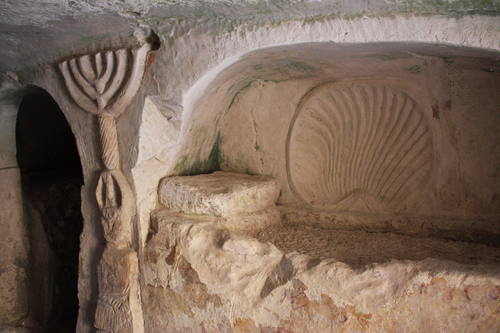Calling it "a landmark of Jewish renewal," the UNESCO's World Heritage Conference described the site: "Consisting of a series of catacombs, the necropolis of Bet She'arim developed from the 2nd century BCE onwards as the primary Jewish burial place outside Jerusalem following the failure of the second Jewish revolt against Roman rule. Located southeast of Haifa, these catacombs are a treasury of artworks and inscriptions in Greek, Aramaic and Hebrew. Beh She’arim bears unique testimony to ancient Judaism under the leadership of Rabbi Judah the Patriarch, who is credited with Jewish renewal after 135 CE."
The ancient Jewish town of Bet She'arim reached its zenith in the 2nd-4th centuries CE. The inhabitants of Bet She'arim hewed grand tombs deep within the hill, with rock-cut burial chambers and stone coffins (sarcophagi). The rooms and the sarcophagi feature an abundance of carved reliefs, inscriptions and wall paintings. Stone-carved doors, which imitate the style of wooden doors, were fashioned to close some of the caves.
 The necropolis of Bet She'arimCopyright: Tsvika Tsuk, Israel Nature and Parks Authority
The necropolis of Bet She'arimCopyright: Tsvika Tsuk, Israel Nature and Parks AuthorityIn the third century CE, Bet She'arim became a renowned Jewish center due to the presence of the spiritual leader Rabbi Judah Hanasi, head of the Sanhedrin. The Roman authorities, who supported his leadership, gave him much property, including an estate at Bet She'arim. Rabbi Judah moved the Sanhedrin from Shefar'am to Bet She'arim, and towards the end of his life to Zippori. He was buried at Bet She'arim in 220 CE, garnering fame for its cemetery in the Jewish world throughout in the talmudic
The
Israel Nature and Parks Authority noted that the site is the oldest and most densely populated cemetery in Israel, and one of the most crowded burial sites in the Roman world, similar to the catacombs in Rome. "This is the most important ancient Jewish cemetery, and it contains a wide variety of architectural burial styles, containing a varied wealth of Classical Oriental Roman art, combined with folk art, with hundreds of inscriptions in four languages - Hebrew, Greek, Aramaic and Palmyric."
Last year, Beit Guvrin was declared a World Heritage Site. Other sites previously added to the prestigious list were the
Nahal Me’arot Nature Reserve, the Baha'i holy sites in Haifa and the Western Galilee, the Incense Route and its Nabatean towns, the biblical tels of Megiddo, Hazor and Be'er Sheva, The White City of Tel Aviv, Masada and the Old City of Acre. The Old City of Jerusalem and its walls were the first Israeli heritage site declared by UNESCO, in 1981.